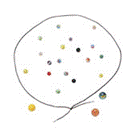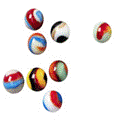
People have been playing marbles and marble-like games for thousands of years. Historians believe that marbles started with cave people playing with small rounded pebbles or balls of natural clay. Clay balls have been found in the tombs of Egypt, in Native American burial grounds and in the ancient Aztec pyramids. For thousands of years, marbles have been one of the world’s most popular, interesting and entertaining games.
There has been a National Marbles Tournament since 1922; for many of those years it has been held in Wildwood, New Jersey. The group of girls and boys that compete in the tournament are fourteen years and younger with male and female divisions. The tournament is four days long. The National Marbles Tournament’s official game is Ringer, a game that originated from one of the oldest marble games Ringtaw.
Today, electronic marble games can be played on the Internet.

Bombing or Bombies – This term is used when you drop your marble onto another marble.
Dubs – This is when two or more marbles are knocked out of the ring with a single shot.
Fairsies – A game rule stating that each player gets back all his or her marbles at the end of play. This rule is decided before play begins.
Keepsies of Friendlies – A game rule stating that any marbles a player looses are not returned at the end of the game, but kept by whoever won them.
Lagging – In marbles you don’t flip a coin to see who goes first. You shoot or bowl a marble from the pitch line to another parallel line called the lag line. The closet to the lag line goes first.
Lag Line – This is the line you throw toward when lagging.
Mibs – These are the target marbles, or the ones you shoot at.
Mibster – This is the name for a person who plays marbles.
Pitch Line – This is the line you stand behind to lag.
Jumpsies or Skipping – This is when you shoot your marble in such a way that it jumps into the air and hits the target marble on landing without hitting the ground first.
Shooter – The marble you shoot with; it is generally larger than a regular marble.
Slip – This is when a marble slips out of a player’s hand accidentally.
Target Marble – The marble you are aiming at.
Taw – The marble you are shooting with; also called the shooter.
Taw Line – The line that you shoot behind.

You can play marbles inside or outside. Inside you can play on any surface: tile, wood, carpet or on a mat. Inside use tape, string or yarn to make a circle. If you are playing outside, find a smooth, flat surface away from busy roads, driveways or sidewalks. On outside cement surface or pavement, use chalk to draw boundaries for your game. In dirt or sand, make a circle with a stick; this is how Esperanza, Ramón Pinto, Carlos, Tío Francisco and Ndeh-zin played marbles.


Before you start to play, decide if you are playing a game of “friendlies” or “keepsies”. In a friendly game, everyone takes his or her own marbles home at the end of play. In a “keepsies” game, it’s an agreed on competition with the winner taking home all the marbles.

There are many different ways to shoot a marble:
|

Ringer TawPlayers: 2 to 6 Needed: Marbles (13 mibs and 1 shooter per player minimum) and a circle. Rules:
Source: What’s That Game |
Marble GolfPlayers: 2 to 6 Needed: Marbles (13 mibs and 1 shooter per player minimum) and a circle. Rules:
Source: What’s That Game |
HundredsPlayers: 2 Needed: Marbles (13 mibs and 1 shooter per player minimum) and a circle. Rules:
|
Football MarblesPlayers: 2 – 4 Needed: Marbles (13 mibs and 1 shooter per player minimum) and a football shape. Rules:
|

| Supplies: Measuring cups Measuring spoons Saucepan Spoon Plate or tray Stove Ingredients: Salt Flour Alum Water Vegetable Oil Optional: Food coloring or paint |
Add to saucepan: 1 and ½ Cups 1 and ½ Cups of flour of flour |
1 and ½ Cups of salt of salt |
4 teaspoons  of alum  |
Slowly add 1 and ½ Cups of water  Stir and break up any lumps |
Place saucepan over low heat and stir constantly. Mixture will become rubbery. Stop stirring when it becomes difficult.
|
Add ¼ Cup of vegetable oil and stir until well-blended until well-blended |
Place the clay on a plate, tray or aluminum foil to cool. If it is sticky to the touch after cooling, add a small amount of flourand knead it. If you want to color your marbles, add a few drops of food coloring to the clay; use plastic bags to cover your hands. You can also paint the clay marbles after they have dried. | Roll clay into marbles. Try to make them all the same size except for shooters. Shooters should be a 5/8th inch diameter. Allow the marbles to air dry for two days before painting or handling. Do not bake. |
 Playing Marbles in Esperanza Means Hope
Playing Marbles in Esperanza Means Hope
Become a real “mibster”. Study the Marble Playing Terms and when ready, take the 10 point quizto show your readiness to play a game of “mibs”. |
Write a multi-paragraph response to the writing prompt – Playing Marbles in Esperanza Means Hope. Revise and edit your writing and on a new sheet of paper, write a final draft to be evaluated by your teacher. | Learn the three ways to shoot marbles by reviewing the diagrams. Practice until you feel confident with your skills and then challenge a friend to play a gameof inside marbles with you. |
| Take home a copy of the Clay Marbles Recipe and make a “batch” of clay marbles. Bring your “mibs” to school and share them with the class and then challenge friends to a game of marbles using your NEW clay ones. Optional: Make a bag to store your marbles. | Read the Marble History paragraphs and think about marbles long history. Add your thoughts to the Marble History Response Poster. Then organize a marble tournament with your friends. Playone of the inside marble games.  |
Play one of the free online marble(FOG) games. Keep track of your scores.
Do you like the hands-on marble games or the online marble games better? Why? Take the marble survey to add your opinion to the comparison study. |
Describe the three times when marble playing occurred in the story and why the game was significant each time. Name the players, under what circumstances they played the game and with what result or outcome. (Go beyond telling who won or lost; explain how relationships changed when the games were played.) Marble playing between story characters occurs on the following pages: pp. 6 – 10, pp. 109 – 114 and p. 232.
Directions: Circle your answers and then fold your paper and place your survey into the envelope. All surveys will be tabulated at the end of the study.

Our Personal Views
What makes the game of marbles so long-lasting?